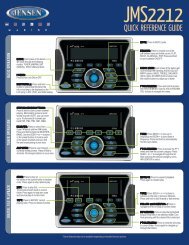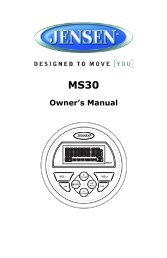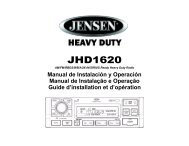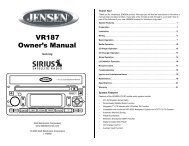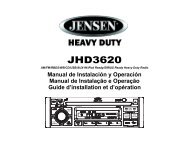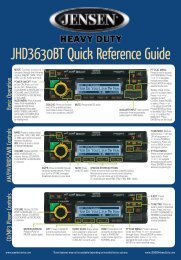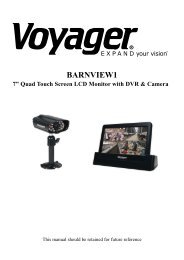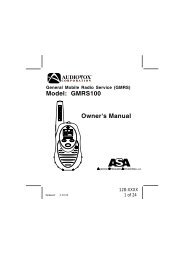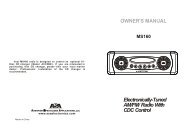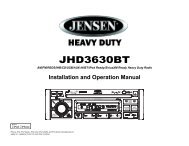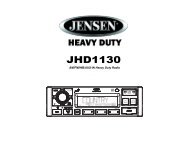JRV212T Owners Manual - Jensen Heavy Duty
JRV212T Owners Manual - Jensen Heavy Duty
JRV212T Owners Manual - Jensen Heavy Duty
Create successful ePaper yourself
Turn your PDF publications into a flip-book with our unique Google optimized e-Paper software.
<strong>JRV212T</strong>WEATHER BAND OPERATIONWhat is the NOAA Weather Radio/Weatheradio Canada?NOAA (National Oceanic and Atmospheric Administration) is a nationwide system that broadcastslocal weather emergency information 24 hours a day via the National Weather Service (NWS)network. The U.S. network has more than 530 stations covering the 50 states as well as theadjacent costal waters, Puerto Rico, the U.S. Virgin Islands and the U.S. Pacific Territories. Eachlocal area has its own transmitting station and there are a total of seven broadcasting frequenciesused. A similar system is available in Canada under the Weatheradio Canada service administeredby Environment Canada.Weather Band Selection1. Press the AUDIO button (4) on the control panel to enter Audio mode (if needed).2. Touch the “WB” button on the touch screen to access the weather band (NOAA sevenfrequency broadcast).TUNE+TUNE-SEEK+162.475 MhzThe indication "WB" will appear on the display panel, along with the current number andchannel indication: "WB-1", “WB-2", "WB-3", "WB-4", "WB-5", "WB-6" or "WB-7".3. Touch the “TUNE+” or “TUNE-” button to tune to a weatherband station or touch the a buttonlabeled 1-7 to access one of the seven weatherband channels directly. The seven frequenciesare shown in the following table:Frequency (MHz)Preset162.400 2162.425 4162.450 5162.475 3162.500 6162.525 7162.550 1AM/FMSATUSBF.AUXWBCDiPODR.AUX1 2 3 4 5 6 7This table also shows which preset button will access the frequency. Note that one frequencycannot be accessed using a preset button. The frequency can only be reached using the tuningcontrols.NOTE: The weather band channel frequency is fixed in preset memory and cannot bechanged.NOAA Weather AlertThe Weather Alert function adds an additional level of user safety by automatically switching fromany of the available function modes to weather band for a minimum of 60 seconds if a NOAAwarning tone (1050 Hz) is received/detected. If no additional warning tone is received for 60seconds, the unit will switch back to the last known function mode.The <strong>JRV212T</strong> is equipped with a weather alert level (Min Alert Level) and weather alert power(Auto-On Enable) feature that will cause the radio to turn on automatically when a weather alert isdetected, adding an additional level of user safety. When the weather alert level is set to “All”,“Warnings” or “Watches” the weather alert function automatically switches from any of the availablefunction modes (Tuner, SIRIUS, CD, iPod, AUX) to Weather Band when the selected NOAAwarning type is received/detected.See “System Menu” on page 9 to learn how to turn the Min Alert Level and Auto-On Enable featureson.SAME Decoding and FilteringSpecific Area Message Encoding (SAME) data is also broadcast prior to alert broadcasts. SAMEdata contains information about the geographic region affected by the alert, the type of alert, and itseffective time. The geographic region included in the SAME data is called the Geographical Areacode and has the form PSSCCC where “P” represents a portion of the county, “SS” is a two-digitstate, territory, or offshore marine area identifier and “CCC” identifies the county, province, or majormetropolitan area within the state. This unit can be configured through the system setting menu withup to seven Geographical Area codes to limit the automatic tuning or power on functions describedabove.SAME data also includes the type of alert being broadcast. This unit can be configured through theSystem Setting Menu to limit the automatic tuning or power on functions based on the type of alert.SAME is activated by programming a 6 digit code - called a FIPS code - into your radio. The FIPScode or Federal Information Processing System code is a six digit code that identifies the states andcounties (or parishes) in the United States. The first digit identifies the county subdivision. The nexttwo digits identify the state or territory, and the last three identify the county. The FIPS code for yourarea can be found by calling the NWS toll free number or visiting the web site.The phone number is 1-888-NWS-SAME (1-888-697-7263) Upon calling, an automated system willprompt you to enter your state and county. When you confirm the information, the system willprovide your six digit FIPS code.The web site is: www.nws.noaa.gov/nwr/indexnw.htm. Upon selecting your state from the chart, youwill see a listing of all the counties in that state. For each county there is a listing of the SAME#(FIPS code), the location of the transmitter, the WB frequency, the call sign, the transmitter powerand miscellaneous remarks.13




